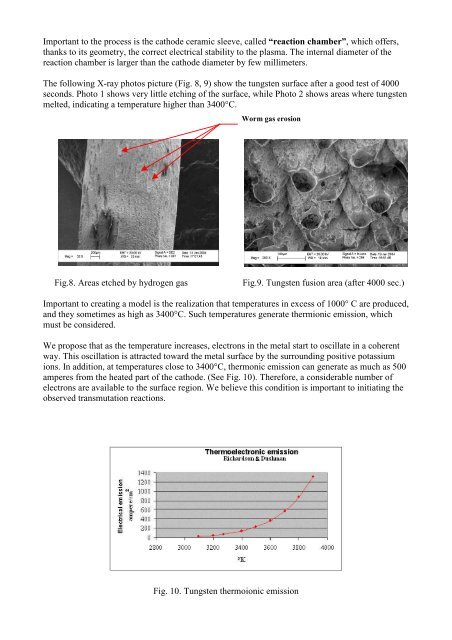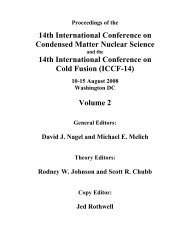Transmutation of metal at low energy in a confined ... - LENR-CANR
Transmutation of metal at low energy in a confined ... - LENR-CANR
Transmutation of metal at low energy in a confined ... - LENR-CANR
You also want an ePaper? Increase the reach of your titles
YUMPU automatically turns print PDFs into web optimized ePapers that Google loves.
Important to the process is the c<strong>at</strong>hode ceramic sleeve, called “reaction chamber”, which <strong>of</strong>fers,<br />
thanks to its geometry, the correct electrical stability to the plasma. The <strong>in</strong>ternal diameter <strong>of</strong> the<br />
reaction chamber is larger than the c<strong>at</strong>hode diameter by few millimeters.<br />
The fol<strong>low</strong><strong>in</strong>g X-ray photos picture (Fig. 8, 9) show the tungsten surface after a good test <strong>of</strong> 4000<br />
seconds. Photo 1 shows very little etch<strong>in</strong>g <strong>of</strong> the surface, while Photo 2 shows areas where tungsten<br />
melted, <strong>in</strong>dic<strong>at</strong><strong>in</strong>g a temper<strong>at</strong>ure higher than 3400°C.<br />
Worm gas erosion<br />
Fig.8. Areas etched by hydrogen gas Fig.9. Tungsten fusion area (after 4000 sec.)<br />
Important to cre<strong>at</strong><strong>in</strong>g a model is the realiz<strong>at</strong>ion th<strong>at</strong> temper<strong>at</strong>ures <strong>in</strong> excess <strong>of</strong> 1000° C are produced,<br />
and they sometimes as high as 3400°C. Such temper<strong>at</strong>ures gener<strong>at</strong>e thermionic emission, which<br />
must be considered.<br />
We propose th<strong>at</strong> as the temper<strong>at</strong>ure <strong>in</strong>creases, electrons <strong>in</strong> the <strong>metal</strong> start to oscill<strong>at</strong>e <strong>in</strong> a coherent<br />
way. This oscill<strong>at</strong>ion is <strong>at</strong>tracted toward the <strong>metal</strong> surface by the surround<strong>in</strong>g positive potassium<br />
ions. In addition, <strong>at</strong> temper<strong>at</strong>ures close to 3400°C, thermonic emission can gener<strong>at</strong>e as much as 500<br />
amperes from the he<strong>at</strong>ed part <strong>of</strong> the c<strong>at</strong>hode. (See Fig. 10). Therefore, a considerable number <strong>of</strong><br />
electrons are available to the surface region. We believe this condition is important to <strong>in</strong>iti<strong>at</strong><strong>in</strong>g the<br />
observed transmut<strong>at</strong>ion reactions.<br />
Fig. 10. Tungsten thermoionic emission












